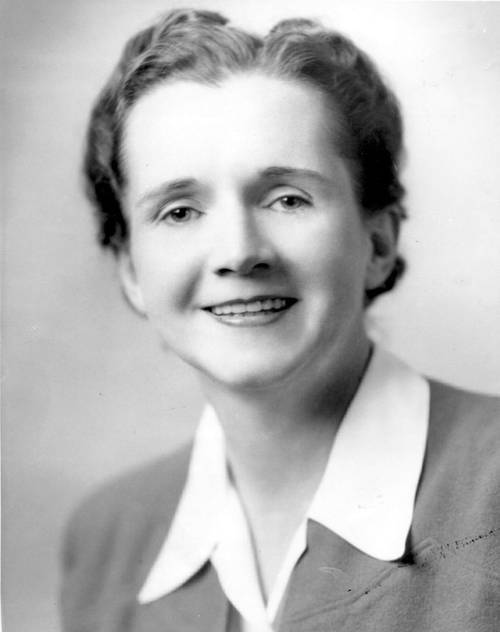
FAQ About Rachel Carson

Who was Rachel Carson?
Rachel Carson was a renowned marine biologist, author, and conservationist born on May 27, 1907, in Springdale, Pennsylvania. She is best known for her book Silent Spring, which is credited with advancing the global environmental movement by bringing attention to the environmental effects of pesticides.

What is Rachel Carson's most famous book?
Rachel Carson's most famous book is Silent Spring, published in 1962. This groundbreaking work exposed the environmental and health risks associated with the widespread use of synthetic pesticides, particularly DDT. Her work played a critical role in the ban of DDT and the rise of the environmental movement.

How did Rachel Carson contribute to the environmental movement?
Rachel Carson contributed significantly to the environmental movement through her writings, most notably Silent Spring. Her meticulous research and compelling narrative highlighted the adverse effects of pesticides on both the environment and human health. This sparked public concern and led to new policies regulating pesticide use in the United States and helped inspire the modern environmental movement.

What impact did 'Silent Spring' have on pesticide regulation?
Silent Spring had a profound impact on pesticide regulation by raising public awareness about the dangers of indiscriminate pesticide use. The public outcry that followed led to policy changes and eventually resulted in the establishment of the Environmental Protection Agency (EPA) in 1970, which played a role in banning the agricultural use of DDT in the United States.

What awards did Rachel Carson receive for her work?
Rachel Carson received numerous honors and awards for her contributions, including the National Book Award for Nonfiction for her earlier work The Sea Around Us. After the publication of Silent Spring, she also received significant recognition, including being posthumously awarded the Presidential Medal of Freedom by President Jimmy Carter in 1980.

What was Rachel Carson's educational background?
Rachel Carson earned a Bachelor’s degree in biology from the Pennsylvania College for Women (now Chatham University) in 1929. She later received a Master’s degree in zoology from Johns Hopkins University in 1932. Her strong academic background laid the foundation for her influential career as a marine biologist and environmental advocate.

Did Rachel Carson face any opposition for her views?
Yes, Rachel Carson faced considerable opposition from chemical companies and some government agencies after the publication of Silent Spring. These entities launched campaigns to discredit her and her work, arguing that banning pesticides like DDT would harm agriculture and cause economic loss. Despite this, her evidence-based approach ultimately garnered widespread public support.

What inspired Rachel Carson to write 'Silent Spring'?
Rachel Carson was inspired to write Silent Spring after becoming aware of the detrimental effects of pesticides on the environment. Her interest was spurred by letters from a friend, Olga Owens Huckins, who described dead birds around her property after aerial spraying of DDT. This prompted Carson to dig deeper into the issue, leading to her groundbreaking book.

How did 'Silent Spring' contribute to the establishment of Earth Day?
Silent Spring played a crucial role in heightening awareness about environmental issues, leading to the first Earth Day on April 22, 1970. The book catalyzed public discourse on pollution and environmental degradation, contributing to a national and international environmental consciousness that encouraged the celebration and recognition of Earth Day.

What other books did Rachel Carson write?
Besides Silent Spring, Rachel Carson authored several other notable works, including Under the Sea-Wind (1941), The Sea Around Us (1951), and The Edge of the Sea (1955). These books demonstrated her extensive knowledge of marine biology and captivated audiences with their blend of science and storytelling.

Why is Rachel Carson considered a pioneer in environmentalism?
Rachel Carson is considered a pioneer in environmentalism due to her role in raising awareness about human impacts on nature, particularly through her book Silent Spring. Her work helped shift public attitudes and policy towards more sustainable environmental practices, laying the groundwork for the modern environmental movement.

What was the main argument of 'Silent Spring'?
The main argument of Silent Spring was that the indiscriminate use of pesticides, such as DDT, was having devastating effects on wildlife, ecosystems, and human health. Carson advocated for a change in the way chemicals were used in agriculture and called for greater regulatory oversight to prevent environmental damage.

How did Rachel Carson's early life influence her career?
Rachel Carson's early life on a family farm in Springdale, Pennsylvania, instilled in her a deep appreciation and fascination for the natural world. Her childhood experiences exploring nature and reading about marine life fueled her desire to pursue a career in biology and ultimately led her to become an influential environmental advocate.

When did Rachel Carson pass away and what was the cause?
Rachel Carson passed away on April 14, 1964, from breast cancer. Despite her illness, she continued to work on her environmental advocacy, ensuring her message about the dangers of pesticides would reach a broad audience and spark significant change.

How did Rachel Carson's work influence public awareness about environmental issues?
Rachel Carson's work, particularly Silent Spring, significantly influenced public awareness by bringing detailed information about the environmental impacts of pesticides to the forefront of public debate. Her accessible writing style made complex scientific concepts understandable to the general public, fostering greater environmental consciousness and advocacy.

What was one of Rachel Carson's major scientific achievements?
One of Rachel Carson's major scientific achievements was her ability to synthesize scientific knowledge about the environmental impacts of pesticides and communicate it effectively to the public and policymakers. Her work brought about a paradigm shift in how people understand the balance between technological progress and environmental preservation.

Did Rachel Carson work in any governmental positions?
Yes, Rachel Carson worked for the U.S. Bureau of Fisheries, which later became the Fish and Wildlife Service. She started as a writer and, due to her scientific expertise and communication skills, eventually became the Editor-in-Chief of all the service's publications, playing a crucial role in their educational and conservation efforts.

How has Rachel Carson's legacy impacted today's environmental policies?
Rachel Carson's legacy has had a lasting impact on today's environmental policies by anchoring the argument for rigorous scientific assessment and regulation of chemicals. Her work laid the groundwork for the formation of environmental agencies and policies worldwide focused on safeguarding ecological health and ensuring sustainability.

What challenges did Rachel Carson overcome during her career?
During her career, Rachel Carson overcame numerous challenges, including gender discrimination in a male-dominated scientific community, financial difficulties, and significant health issues. Despite these obstacles, she persevered and produced groundbreaking work that profoundly influenced environmental policy and public awareness.

What role did Rachel Carson play in marine biology?
Rachel Carson was a pioneer in marine biology, conducting extensive research and writing influential books that popularized marine science. Her ability to weave scientific detail with poetic narrative in books like The Sea Around Us helped foster a deeper public appreciation and understanding of marine environments and their importance to Earth's ecological balance.
